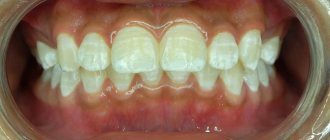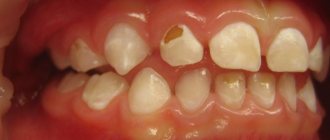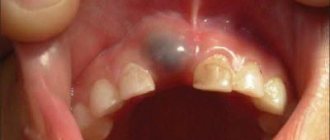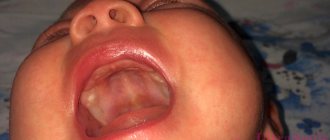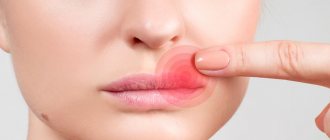Chalk-like stains can sometimes be found on the shiny surface of tooth enamel . They usually have a matte white color, but sometimes there are spots of a light beige hue.
It is quite easy to identify such stains on teeth even on your own - they do not have the characteristic shine inherent in healthy tooth enamel.
There are several reasons for this phenomenon. But before you find out, remember that the appearance of chalky spots is a reason to consult a dentist. Based on the nature of their origin, the doctor will make a diagnosis and prescribe appropriate treatment, if required.
Together with esthet-portal. com we suggest you figure out what the appearance of chalky stains means and what to do to get rid of them?
• Causes of chalk stains in adults • How to respond to chalk stains on baby teeth • How to get rid of chalk stains yourself • Dental solution to the problem • Prevention of chalk stains on teeth
The mechanism of the problem
The health of dental units is ensured by a number of substances: these are vitamins A, C, E, D, group B, potassium, iron, iodine, magnesium, zinc and others. But the two main elements necessary to maintain the functionality of the jaw are calcium and fluoride.
Due to injury, work in a toxic industry, insufficient hygiene, or the accumulation of pathogenic bacteria on the surface of the enamel, it can lose useful compounds, which is why white spots, dots or stripes appear on the teeth (we will consider the result with a photo below).
What to do if a white spot appears
Do not experiment with treatment. You should not try to remove them with soda, acids and other aggressive substances. Since the appearance of the stain is due to weakening of the enamel. This requires restoration, during which you should treat your teeth very carefully. Do not use hard brushes or whitening pastes, otherwise the light spots will quickly turn into superficial caries.
With proper care there is no need to be afraid of this. Pay special attention to your diet. Add foods rich in calcium, zinc and magnesium to your diet.
You can additionally take a course of vitamins and minerals. The ASEPTA vitamin and mineral complex, designed specifically to maintain dental health, is perfect. It will help strengthen blood vessels, increase the resistance of the oral cavity to infections, and improve the condition of dental tissues.
As for diet, eat seafood, fish, meat, fruits and green vegetables, and herbs more often. Try to reduce the amount of sweets, refined oils and other junk foods as much as possible.
How do stains appear on the enamel surface?
The surface of a healthy tooth is smooth and glossy. But it is constantly affected by many destructive factors.
Acids released by microorganisms can wash minerals out of the enamel, thus gradually becoming weaker. This happens when bacteria and their waste products (soft plaque) accumulate on the teeth. All this is a direct consequence of poor hygiene or eating too many sweets. In addition, poor immunity and poor health can also have an impact.
Also, the cause of white spots can be a lack of calcium and vitamin D. This situation leads to multiple caries. It is usually triggered by poor nutrition, poor sleep or prolonged stress. In this case, it is necessary to improve the health of the whole body. It is best to undergo a full examination and tests to know exactly what you are dealing with.
If the dots appear from an excess of fluoride, it is better to significantly reduce its intake with food, and also switch to toothpastes that do not contain this element in their composition.
Treatment
In cases where white spots are harbingers of superficial caries, remineralizing therapy will help. Today, dentists offer many options on how to reverse negative processes and strengthen teeth. The most popular of them: fluoridation, ozone, ICON, mineralization, electrophoresis. The list, of course, does not end there. Your doctor will decide which solution is best for you. He will definitely give you some tips to improve the general condition of the body. After all, weakening teeth indicate a lack of minerals. Therefore, therapy alone will not be enough. Good nutrition and sleep are very important, and perhaps take a break for a while to reduce stress.
In addition, you can help the dentist by using specialized toothpastes and taking vitamins. You can also use various folk remedies in moderation. In any case, be sure to consult your doctor about this. These methods are not a panacea. They only help speed up the recovery process.
We offer several simple recipes:
- Mix one teaspoon of vinegar and two teaspoons of baking soda to form a paste. Brush your teeth with this mixture for about two minutes, rinse your mouth thoroughly. Repeat the procedure twice a week.
- You can try using lemon juice and salt, but you need to do this with great caution. This procedure will help remove stains and reduce bad breath.
- You can also periodically rub banana peels on your teeth; they are full of magnesium, calcium and manganese. After this, be sure to brush your teeth thoroughly, as leftover banana peels can become good food for bacteria.
Prevention
It is easiest to detect on the front teeth, but if they appear in a place that is difficult for the eyes to see, everything is much more complicated. This will most likely lead to a diagnosis of dental caries. But there is an excellent option to reduce this probability to a minimum - prevention.
Dental care in this case includes dental care, home daily activities and improved nutrition.
Professional care
Even if not a single tooth hurts, do not forget to visit the dentist once or twice a year. A specialist will help identify problems in the early stages, which means their treatment will be easier and much cheaper.
In addition, WHO recommends that everyone have their teeth professionally cleaned every year. No matter how thoroughly we brush our teeth, food debris can still accumulate, forming soft and hard plaque in hard-to-reach places. A good cleaning will help you get rid of all this, and in addition, it will allow the true color of the enamel to come out, getting rid of unnatural yellowness.
Today there are several types of cleaning:
- laser – deposits are removed by heating the enamel with a beam of light;
- ultrasonic will help remove not only soft deposits, but also tartar; cleaning is carried out using a special device - a scaler - it creates high-frequency sound vibrations;
- cleaning with professional pastes and brushes with hooks to remove plaque;
- Air Flow is a procedure in which teeth are polished with an abrasive solution that is supplied under pressure.
Most often, the procedure includes several cleaning options at once. That is, the doctor first removes hard deposits with ultrasound, then polishes with Air Flow and finally coats the teeth with a special fluoridating solution. Technologies may vary. But their main goal is to clean the teeth as much as possible and protect them from harmful effects for some time.
Home care
If you want to keep your teeth healthy, use high-quality specialized toothpastes, and don’t forget about dental floss and rinses. An integrated approach will help reduce the risk of caries, as it can significantly reduce the number of bacteria in the oral cavity. Carry out the procedures at least twice a day. It is best to use dental floss or at least chewing gum after each meal.
Diet and lifestyle
Watch what you eat carefully. Avoid a lot of sweets and other unhealthy ones. Try to reduce the number of cigarettes you smoke if you have this bad habit.
Sources:
- Report on the determination/confirmation of the preventive properties of personal oral hygiene products “ASEPTA PLUS” Remineralization doctor-researcher A.A. Leontyev, head Department of Preventive Dentistry, Doctor of Medical Sciences, Professor S.B. Ulitovsky First St. Petersburg State Medical University named after. acad. I.P. Pavlova, Department of Preventive Dentistry
- The use of new anti-inflammatory drugs in the complex of therapeutic and preventive measures for periodontal diseases (E.D. Kuchumova, A.A. Leontyev, O.V. Kalinina, L.Yu. Orekhova, S.B. Ulitovsky) E.D. Kuchumova, Ph.D., Associate Professor, A.A. Leontyev, dentist, O.V. Kalinina, dentist, L.Yu. Orekhova, Doctor of Medical Sciences, Professor, Head of Department, S.B. Ulitovsky, Doctor of Medical Sciences, Prof. Department of Therapeutic Dentistry of St. Petersburg State Medical University named after. acad. I.P. Pavlova
- The role of anti-inflammatory rinse in the treatment of periodontal diseases (L.Yu. Orekhova, A.A. Leontyev, S.B. Ulitovsky) L.Yu. OREKHOVA, Doctor of Medical Sciences, Prof., Head of Department; A.A. LEONTIEV, dentist; S.B. ULITOVSKY, Doctor of Medical Sciences, Prof. Department of Therapeutic Dentistry of St. Petersburg State Medical University named after. acad. I. P. Pavlova
What does the pathology look like?
Initially, a very small speck is detected, which is difficult to notice with the naked eye. Over time, the focus of demineralization increases. The affected areas lose their natural shine because the crystalline structure of the substance covering the dentin is destroyed: it becomes porous, darkens and, due to a change in texture, turns into a reservoir for pathogenic microorganisms. At first, such microdestructions are painless, which indicates the need for visual control.
Most often, canines and incisors are affected, but sometimes pathology occurs on molars. It is important to notice it in time - the process is reversible with early diagnosis. If it is neglected, only radical methods of treatment will help (drilling, installing a large filling).
Aesthetic correction in the presence of chalky spots
This article demonstrates the possibilities of using the direct composite restoration method for comprehensive aesthetic correction of incisors with chalky spots on the surface. Local discolorations of hard dental tissues most often have a non-carious origin and are characterized by a violation of the enamel structure in the area of the lesions. The appearance of chalky spots does not lead to painful sensations, but in almost all cases their presence causes aesthetic discomfort to the patient.
Considering that the number of patients with white spots on their front teeth is growing every year, the study of methods for correcting such defects becomes especially relevant. In such a situation, the main task is the correct choice of technique to minimize the invasiveness of treatment. Depending on the area of the chalky areas and the depth of their distribution, different options for aesthetic correction should be used, respectively.
For superficial spots (up to 0.2 mm), microabrasion with a gel containing hydrochloric acid with silicon carbide particles is indicated to reduce the surface layer of enamel. If the depth of the lesion is more than 0.2 mm, the only method that allows to achieve complete aesthetic correction with minimal invasion of the tooth tissue is direct composite restoration.
Clinical case
The spots are located almost symmetrically on the four upper incisors, as well as the upper first molars. The enamel in the area of the stains is smooth, the surface is without defects, the stains are not stained with low molecular weight dye, and their presence does not cause pain. The presumptive diagnosis is mild (spotty) systemic hypoplasia.
A detailed analysis of the surface of the teeth reveals a pronounced microrelief, deep atypical perikymatia, enamel ridges and pronounced lines of Retzius in the cervical and middle third. Optically, a fairly high level of transparency of the incisal edge with a distinct mamelon pattern is determined, despite the fact that the visual assessment is hampered by opaque white spots. A characteristic feature of this clinical case is the pronounced susceptibility of the teeth to intense dehydration.
Rice. 1. Initial situation. Rice. 2. Initial situation. Rice. 3. View of teeth after isolation.
Even after a short external examination, the hard tissues of the teeth began to noticeably change in color. It is reasonable to assume that the pathogenic factors that led to the occurrence of local changes in the form of white spots could also affect the structure of the tissues as a whole, making them less dense and, as a result, more hygroscopic.
The method of direct composite restoration with preliminary minimally invasive excision of altered tissues with a diamond bur under microscope control was chosen as treatment. Professional dental hygiene had to be carried out in a separate visit: during the cleaning process, changes associated with tissue dehydration turned out to be too pronounced, which made it difficult to select the shade of the composite. Treatment was continued only the next day. Despite the difficult conditions for analyzing the optical properties and color, the shade was still determined - sample A2 on the Vita scale.
However, due to the fact that the intervention was limited to working in the surface layer of transparent enamel, to reproduce the excised tissue, it was sufficient to use one opalescent shade of YE material Esthet-XHD. The depth of occurrence of white spots in the dental tissues turned out to be very uneven - from 0.1-0.2 mm on the surface to 0.6-0.8 mm in the deepest areas, however, in all teeth the spots were located within the enamel. All work from start to finish was carried out under a microscope with magnification of 10 and 16 times. The preparation was carried out with diamond burs with red and yellow stripes under intense water cooling.
After isolation and before applying the conditioner, the enamel was air-abrasively prepared with aluminum oxide sand (25 microns). This stage allows you to increase the specific surface area of the enamel and improve its wettability, which leads to an increase in adhesion strength.
Rice. 4. View after excision of white spots with a bur. Rice. 5. View after excision of white spots with a bur. Rice. 6. View after excision of white spots with a bur. Rice. 7. View of teeth after sandblasting and etching. The teeth are separated from each other by Mylar matrices to prevent the adhesive from reaching the contact point.
To prevent rapid hardening of the composite material, an orange filter was installed under the light of the microscope.
The duration of the work was approximately 3 hours. During finishing, a coarse diamond bur with a green stripe was used to imitate the natural microrelief of the patient's teeth. By taking it with your fingers and making careful horizontal movements, you can successfully imitate deep perikymatia and other non-standard enamel formations.
Rice. 8. View after applying the restoration material. Rice. 9. Contouring, grinding and polishing of the restorations was carried out directly under the rubber dam. Rice. 10. View of the finished restorations immediately after polishing. Rice. 11. View of the restorations the day after completion of treatment. Thanks to painstaking surface treatment and reproduction of all the nuances of the enamel surface, the boundaries of the composite are practically indistinguishable.
Conclusion
In the event that white spots in mild forms of hypoplasia lie at a depth of no more than 0.2 mm, it is possible to use microabrasion with special pastes, however, in cases where the altered areas spread deeper, it is already necessary to resort to minimally invasive direct restoration, as the most gentle possible methods.
Rice. 12. View of the restorations the day after completion of treatment. Thanks to painstaking surface treatment and reproduction of all the nuances of the enamel surface, the boundaries of the composite are practically indistinguishable. Rice. 13. View of the restorations the day after completion of treatment. Thanks to painstaking surface treatment and reproduction of all the nuances of the enamel surface, the boundaries of the composite are practically indistinguishable. Rice. 14. View of the restorations the day after completion of treatment. Thanks to painstaking surface treatment and reproduction of all the nuances of the enamel surface, the boundaries of the composite are practically indistinguishable.
Working under a microscope provides the necessary control over the accuracy of the preparation, and following the correct adhesive protocol will allow you to achieve very high levels of adhesion between the composite and tooth tissue, which will virtually eliminate the risk of breaking the marginal seal in the future. The prognosis for such restorations is, without any doubt, favorable.
Literature
- Yazici AR, Kiremitçi A, Celik C, Ozgünaltay G, Dayangaç B. A two-year clinical evaluation of pit and fissure sealants placed with and without air abrasion pretreatment in teenagers. J AmDent Assoc. 2006 Oct;137(10): 1401–5.
- MJMC Santos, H Bapoo, AS Rizkalla, and GC Santos, Jr (2011) Effect of Dentin-cleaning Techniques on the Shear Bond Strength of Self-adhesive Resin Luting Cement to Dentin. OperativeDentistry: September/October 2011, Vol. 36, No. 5, pp. 512-520.
Causes of problems in adults
White spots on tooth enamel can have different etiologies. To make an accurate diagnosis, the doctor examines and interviews the patient: he clarifies how oral care is carried out, whether there were injuries or other prerequisites for the appearance of foci of remineralization.
Initial caries
Whitish matte formations may indicate that the pathological process has begun and will soon make itself felt. The main reason for its development is poor hygiene (a person brushes his or her teeth irregularly, not thoroughly enough, or does not floss). The disease can also be caused by an excess of carbohydrate foods in the diet, especially fast carbohydrates (white bread, sweets). The resulting plaque becomes a breeding ground for bacteria and a good “future reserve” for the formation of caries.
If you start therapy at this stage, you can get by with non-invasive procedures, but the neglected process will lead to the destruction of dentin and, as a consequence, to pulpitis (a diagram of pulp damage can be seen in the illustration).
Traumatic impact
It is not so easy to injure the jaw in everyday life, but there is an exception: often the cause of white spots and stains on the teeth is wearing braces and splints. After removal of the orthodontic structure, foci of demineralization are found on the enamel surface; their occurrence could be avoided by observing dietary restrictions and hygiene.
The root cause of lesions under braces is the accumulation of food debris (especially acidic and carbohydrate-rich foods). This is why doctors advise regularly using an irrigator after installing jaw retainers. The surface areas under the locks are poorly moistened with saliva, which aggravates the situation.
Patients who have not been treated by an orthodontist also have white spots on their teeth. They are associated with a constant load:
- frequent consumption of seeds, nuts and other solid foods;
- bruxism (involuntary clenching of the jaws both during sleep and while awake).
Athletes involved in contact martial arts are also at risk.
Industrial or occupational fluorosis
He can be:
- streaked or spotted (mild form);
- chalky-mottled (moderate severity);
- erosive and destructive (severe course of the disease).
It occurs due to excess fluoride in the patient’s body and also leads to the appearance of chalky or transparent spots, specks and stripes on the teeth. The disease manifests itself in people who have worked for a long time in industries with high fluoride concentrations:
- glass, ceramic, cement;
- woodworking;
- oil producing
Workers of hazardous enterprises are recommended to regularly visit the dentist to identify pathology in the early stages and undergo timely treatment.
Hypoplasia
Many dental diseases in an already born baby are a consequence of the incorrect lifestyle of the expectant mother, lack of vitamins, and poor ecology.
White spots on a child’s baby (less often permanent) teeth often occur due to underdevelopment of the enamel. The foundation for its formation in children is laid during the period of intrauterine development - at the 7th week of pregnancy. Permanent incisors and molars are formed from 5 months to 7–8 years.
The most popular prerequisites for the spread of pathology:
- hypovitaminosis D in the mother;
- toxicosis;
- transferred rubella;
- frequent inflammation of the gastrointestinal tract;
- birth injury.
The problem cannot be prevented with a 100% guarantee, but you can make every effort to reduce the likelihood of its occurrence.
Caries in the spot stage: treatment
Treatment of initial caries in the spot stage is carried out conservatively. Because The process of formation of white spots is associated with focal demineralization of tooth enamel (washing out calcium, fluorine and phosphates from it), then we must again saturate the enamel with these microelements. The method of saturating tooth enamel with lost microelements is called “teeth remineralization.”
But there is one important point here. You must understand that the formation of “white caries” does not occur on its own, but due to poor oral hygiene (24stoma.ru). And if the current level of hygiene does not improve, then remineralization of teeth will either not lead to the disappearance of foci of demineralization, or its effect will be insufficient. Therefore, an important role in treatment belongs to your motivation and willingness to pay much more attention to your teeth.
A course of dental remineralization can be home or professional. Remineralization of teeth at the dentist is usually carried out with preparations with a high concentration of fluoride (usually 5% sodium fluoride). As you will see below, highly concentrated fluoride is not the optimal treatment solution for white spots on teeth, although it may lead to a slight reduction in the size of the spots. And below we will explain what this is connected with.
What results can you expect from white spot treatment? –
The effectiveness of tooth remineralization in the treatment of caries in the white spot stage depends on two criteria: 1) the clinical size of the white spot, 2) the level of permeability for the dye. Small white spots measuring up to 3.0-5.0 mm2 inclusive, demonstrating a low degree of dye permeability (1% methylene blue) are usually quite easily reversed. In this case, we can expect their complete disappearance as a result of remineralizing therapy + normalization of hygiene.
But with white spots that demonstrate a high degree of dye permeability, as well as white spots larger than 5.0 mm2 (they can reach sizes up to 28-30 mm2), the situation is completely different. In most cases, you can only count on a reduction in their size, as well as a decrease in their visibility due to a decrease in brightness and restoration of the shine of the enamel. There is a strict dependence: the larger the size of the spot, the less likely it is that it will disappear completely. But in the absence of treatment, with a high probability, carious cavities will form over time at the site of foci of demineralization.
The level of permeability of white spots for dye is determined by conducting a test according to Okushko V.R. (also called the enamel resistance test or TER test). Sensitivity to the dye is determined by a 1% solution of methylene blue. The results are interpreted based on the color intensity of the white spots, using a 10-point blue scale. If the color corresponds to 1-3 points, then there is a high probability that the white spots will completely disappear after remineralizing therapy. When coloring scores 6 or more, you can only count on reducing the size and improving the appearance of the spots.
Thus, the effectiveness of remineralization will be indicated by the complete disappearance of white spots, a reduction in their size, as well as an improvement in their appearance (they should become less noticeable). A simple stabilization of the number and size of white spots will also indicate little effectiveness. If there is no initial caries at the spot stage, the effectiveness of enamel remineralization can be judged by the decrease in the frequency of appearance of new caries lesions (compared to previous periods).
1) Professional products for remineralization –
Starting with a visit to the dentist would be the right decision, because if you have dental plaque, you first need to have your teeth professionally cleaned. Next, the dentist usually suggests treating the teeth with a remineralizing varnish or gel with a high fluoride content (for example, 5% sodium fluoride). The problem is that such remedies will not only be ineffective in eliminating foci of demineralization in the form of white spots, but can also spoil all subsequent treatment if you plan to get rid of the spots in full.
We have already said above that when caries develops in the white spot stage, it is not the enamel surface that undergoes the most severe demineralization, but rather its subsurface layers. The surface layer of the demineralization focus (in the area of the white spot) gradually becomes much denser, and quite a lot of fluorapatite is found in it. The formation of such a well-mineralized “crust” on the surface of the white spot occurs due to several parallel processes.
Firstly, this is a consequence of a protective mechanism due to which minerals migrate from the subsurface layers of enamel to the surface of the demineralization site. The purpose of this defense mechanism is to try to protect the white spot from ongoing "acid attacks" and its development into a carious defect. The second reason lies in the use of products with fluoride against the background of ongoing acid attacks (fluorides against the background of low pH of the oral fluid lead to the formation of fluorapatites in the surface layer of the white spot).
High fluoride content on the surface of the white spot –
Important: thus, if at the very beginning of white spot therapy we immediately treat the teeth with varnish or gel with a high dosage of fluoride (or we use toothpastes with a high dosage of fluoride), this will lead to the creation of white spots on the surface - dense and durable mineral layer with a high concentration of fluorapatite and fluorohydroxyapatite. In the future, this layer will only impede the penetration of calcium and phosphates into the site of demineralization. Although it must be admitted that after such treatment, the size of the white spots may initially decrease slightly.
Therefore, at stage 1, it is undesirable to use professional varnishes and gels for remineralizing teeth containing high concentrations of fluorides. But if the ultimate goal of remineralization is to strengthen teeth and reduce the risk of caries, then such products would be a good choice. For example, this is Colgate Duraphat fluoride varnish with 5% sodium fluoride. This is a fluoride varnish “MI Varnish” - with 5% sodium fluoride and the CPP-ACP complex. This is Clinpro White Varnish - with 5% sodium fluoride and tricalcium phosphate. These are excellent products specifically for strengthening teeth and preventing caries, but not for treating white spots.
Preparations for remineralization of enamel (for the purpose of caries prevention) –
Therefore, if you want to remove white spots on your teeth (striving for the best possible result), you need to start remineralization not with high concentrations of fluoride, but with the Recaldent® complex. This name hides “amorphous calcium phosphate associated with casein phosphopeptides” (abbreviated as CPP-ACP). These are the products “GC Tooth Mousse” and “GC MI Paste Plus”, which are produced - well known among dentists all over the world. These are professional products that can also be used at home, and we will discuss them in detail below.
Electrophoresis of a calcium gluconate solution - by the way, if for various reasons you are having your teeth treated in a public dental clinic, then you can also ask your dentist to give you a referral to a physiotherapy room for electrophoresis of a calcium gluconate solution or calcium glycerophosphate (a course of 10 procedures). This method will also moderately remineralize tooth enamel. But let’s say right away that buying and rubbing tablets with calcium gluconate into tooth enamel will be a completely useless exercise, because... dissociation of calcium gluconate with the release of active calcium ions is possible only through electrophoresis. But after a course of electrophoresis, it would be logical to carry out several dental fluoridation procedures.
2) The best products for self-use -
Dental gels “GC Tooth Mousse” and “GC MI Paste Plus” are recognized by most dentists around the world as the standard for remineralizing therapy for initial caries (in the white spot stage).
But these drugs not only help you fight white spots on your teeth; for example, they will also allow you to significantly reduce the risk of developing caries. But there is a problem with effective white spot remineralization therapy regimens - an inconvenient treatment regimen. Only a course of treatment can be effective - the guideline is 1 month. Moreover, if you do daily procedures 2 times a day (morning and evening - after meals and oral hygiene), it will be more effective than with a single procedure per day. And such long courses mean that you will not be able to go to the dentist in this mode. Small white spots may disappear in a shorter period of time, and in some cases repeated courses of therapy may be required.
The best drugs for the treatment of caries in the white spot stage -
The GC Tooth Mousse and GC MI Paste Plus gels are very easy to use and can be applied to the teeth with your index finger. Unlike many other remineralizing gels, they absolutely do not require the use of dental trays (so that saliva does not reduce the concentration of the gel on the teeth). On the contrary, saliva is necessary for the CPP-ACP complex to form a thick layer of amorphous calcium phosphate on the teeth. Application of the gel lasts from 3 to 5 minutes, during which you should not spit saliva. But after this you can spit out the saliva, and for half an hour you will not be able to eat, drink or rinse your mouth with water. It's simple.
Ingredients : GC Tooth Mousse – contains 10% CPP-ACP (for use in adults and children from 1 year). Gel “GC MI Paste Plus” - contains 10% CPP-ACP + 900 ppm sodium fluoride, and therefore it is used at home only from 12 years of age.
According to research, the effectiveness of the second gel is 15% higher, and therefore, first of all, we recommend it. A low concentration of fluoride in the presence of CPP-ACP stimulates the phase transformations of amorphous calcium phosphate on the enamel surface, as well as the penetration of calcium and phosphate ions into the depths of the demineralization site. Therefore, low dosages of fluoride in the treatment of white spots can, on the contrary, be useful, but only in the presence of a source of calcium and phosphates (which is CPP-ACP).
Important: numerous studies indicate that fluoride ions can not only protect teeth from the development of caries. In the presence of calcium and phosphates, fluoride ions act as a catalyst for the growth of enamel hydroxyapatite crystals, and also ensure remineralization of enamel even at a more acidic pH of 4.5-5.5 (at which demineralization of enamel always occurs under normal conditions). That is why, if you have white spots on your teeth, you should choose products that simultaneously contain both sources of calcium and phosphates, as well as moderate dosages of fluorides.
There are other medications available to remineralize white spots, but they will not be as effective. These include preparations based on calcium glycerophosphate (for example, the inexpensive and popular ROCS minerals gel), brushite (RemarsGel) and some others. Read more about such drugs at the link below.
→ Remineralizing gels “ROCS” and RemarsGel
What diseases cause white spots on teeth to appear in children?
There are several options here:
- Lack of vitamins or minerals - in this case, in addition to visiting the dentist, it is worth visiting the pediatrician to take tests, prescribe medications or adjust the diet.
- Endemic fluorosis - most often occurs in babies living in industrial areas due to excessive saturation of drinking water with fluorides, if the expectant mother works in hazardous industries during pregnancy. In addition to medical intervention, you should, if possible, reconsider your lifestyle and eliminate the use of fluoridating pastes (they are not recommended for children under 4–5 years of age).
- The hypoplasia described above is a common cause of white spots found on dental photographs.
- Hardly started caries is the most common option.
The pathological process, which can develop in an adult for several years, in the case of a child often occurs rapidly and leads first to darkening of the stripes on the enamel, and then to the formation of large carious cavities. If the situation is neglected, the crown will collapse completely, leaving behind only a small black “hole” in place of the element. In addition to physiological reasons, this also occurs due to the difficulty of carrying out hygiene procedures, especially since older relatives often treat the baby with sweets (soda, sweets, fine flour bread). To avoid complications, it is recommended to visit the dentist with your child every 2-3 months.
List of toothpastes with increased remineralizing potential -
So, for such toothpastes to really have a good remineralizing effect, you need to follow the following rules:
- We brush our teeth after every meal, i.e. 3 times a day,
- Before brushing your teeth, use dental floss every time,
- brush your teeth immediately after eating, and not after 10-20 minutes,
- exclude the consumption of carbohydrates and sugary drinks - in the intervals between meals,
- We exclude from the diet foods and drinks with a high content of acids - some fruits and fruit juices, wine.
The only indulgence in oral hygiene that you can allow yourself is brushing your teeth after your lunch break. In this case, you can refuse to brush your teeth with a toothbrush and toothpaste, but you should definitely floss first and then chew gum for 5-7 minutes. After this, use a mouthwash with nano-hydroxyapatite from the Biorepair brand. But let's get back to toothpastes...
Clinpro Tooth Creme toothpaste –
Clinpro Tooth Creme contains protected tricalcium phosphate + 900 ppm sodium fluoride. Use for a course of 2-3 months, or on an ongoing basis. If the result has been achieved (the white spots have disappeared or decreased), then immediately after the end of its use, we recommend using Colgate Duraphat 5000 ppm toothpaste for 4 weeks to consolidate the result.
Toothpaste “Biorepair PLUS Total Protection” –
Biorepair PLUS Total Protection contains 20% nano-hydroxyapatite (50 to 100 nm in size). Duration of use – from 2-3 months to permanent use. If the result has been achieved, then to consolidate it, it is better to use toothpaste with a high dosage of fluoride for 4 weeks. Optimally – “Colgate Duraphat 5000 ppm”.
Colgate Duraphat 5000 ppm toothpaste –
Colgate Duraphat 5000 ppm is an excellent toothpaste designed to strengthen teeth and provide maximum protection against caries. We do not recommend using it to treat white spots on enamel - as a basic treatment. However, it will be an excellent way to consolidate the results obtained from remineralizing therapy (with the means indicated in the article above). In addition, in the future you can use this toothpaste on an ongoing basis - it protects teeth well from caries (even in patients with irregular oral hygiene).
The occurrence of pathology during the gestational period
Pregnancy is stress for the body and a time during which a woman requires an increased concentration of nutrients in food. The fetus needs minerals and vitamins for the correct formation of all systems and organs, so the expectant mother may experience a deficiency of them. It happens that foci of demineralization occur as a result of toxicosis, when, due to constant nausea, an overly acidic environment is created in the mouth.
If a white spot appears on a pregnant woman’s tooth, this means that it is worth visiting not only a dentist, but also a gynecologist to rule out metabolic disorders and alleviate unpleasant symptoms.
Prevention
Preventive measures will help strengthen the surface of the teeth and prevent the appearance of black spots on the enamel. What you can do:
- Brushing your teeth regularly, the type of toothpaste and type of brush should be discussed with your doctor.
- Visit the dentist twice a year for preventive purposes.
- Create the right diet: include foods containing minerals and substances necessary to maintain dental health. These are dairy products, vegetables and fruits (a differentiated approach is necessary, since in some cases the approach to the acids they contain is selective), eggs, lean meat, fish and other products.
It is worth paying attention to additional measures to maintain immunity: do not forget about moderate physical activity, take vitamin and mineral complexes, get vaccinations in a timely manner (especially for children).
Author: Zhukov M.A.
Main symptoms of diseases
The signs of lesions vary, and the prognosis in the absence of timely medical intervention is also different. The final diagnosis should be made only by the attending physician, but the patient can, based on the nature of the pathological process, make an assumption about the root of the problem.
- If the enamel is injured, the person most likely knows about it - he recently removed braces or the jaw was mechanically damaged. Only the area on which pressure was applied or the part of the tissue hidden under the orthodontic structure is treated.
- If a child or adult has white spots on the front teeth (incisors) and molars, the reason is often the development of caries. Such neoplasms are localized randomly, but quickly progress, turn black, and deepen. The focus of the disease is single or few.
- With fluorosis, chalky or pale yellow stripes appear, which later darken.
- Hypoplasia is diagnosed in children and adolescents - and neighboring elements usually suffer.
Is the appearance of white spots on teeth dangerous?
As we said earlier, the spots themselves are not so dangerous, unlike the consequences that will certainly occur if the causes of their occurrence are not diagnosed and treated in a timely manner. In most cases, chalk dots are harbingers of caries. At this stage, it is possible to reverse the process without unnecessary interventions, if there are no other visible damages: cracks, pits - if they are present, you can no longer do without a drill.
But before that, competent remineralization will help save your teeth, which is carried out using special compounds in the dental office, as well as additionally at home. In the second case, you can use ASEPTA PLUS REMINERALIZATION - this is a toothpaste that contains a high concentration of hydroxyapatite. This substance quickly and effectively restores enamel. In addition, the paste contains thermal mud, which strengthens both teeth and gums.
Methods of treating pathology for initial caries
Inflammation at the initial stage is treated without the use of a drill and anesthesia: this is a painless manipulation that prevents damage to dentin, and the enamel can be considered healthy after treatment. In some cases, only the doctor at the appointment sees white spots on the teeth, so it is better to carry out these procedures immediately after identifying the problem.
Remineralization
Remotherapy is the process of artificially saturating tissues with micro- and macroelements. It is also indicated after prolonged use of splints or braces.
Calcium gluconate is most commonly used by dentists. A swab soaked in the solution is applied to the previously cleaned and disinfected jaw and left for exposure for several minutes. Sometimes the procedure requires repetition.
To ensure long-lasting results:
- brush your teeth with a soft brush and low-abrasive toothpaste;
- exclude too cold and hot, spicy, sour foods for a day or two.
Fluoridation
There is significantly more calcium in bone tissue than fluoride. But the latter plays a decisive role in the process of absorption of calcium compounds. The best results are obtained by alternating saturation procedures.
The doctor performs the operation manually using gel, varnish or tampons containing the desired element. After manipulation, it is not recommended to use medicinal pastes for 2 months.
Electrophoresis, infiltration, ozonation
These are more complex, but nevertheless non-invasive or micro-invasive processes that allow you to restore enamel that is beginning to decompose without pain relief using:
- microcurrents delivering the necessary substances (electrophoresis with calcium or fluorine ions);
- ICON lamps, thanks to them the desired material penetrates the pores of the surface, restoring the enamel layer (infiltration);
- gas that disinfects the entire dentition, ridding it of pathogens, followed by the use of a material that prevents the development of caries (ozonation).
The attending physician will offer the patient several options to choose from, and the final decision on what to do if white spots appear on the teeth is made jointly.
Sealing and silvering of enamel in children
Fissures are depressions and grooves on the chewing surfaces, thanks to which the jaws can grind food efficiently. Despite their usefulness, with insufficient care they become a source of inflammation and proliferation of microbes, especially in children who, due to their age, do not yet fully observe hygiene. Considering the fragility of the tissues of a child’s body, this leads to almost instantaneous development of caries. Sealing (filling) is done with a material similar to a filling material.
After manipulation, dentists recommend a coating - for example, with silver nitrate, a bactericide, which prevents further destruction of the units and keeps the oral cavity sanitized.
Types of caries
Dental caries can be single or multiple depending on the number of teeth affected. There are different types of disease depending on the location of the lesion: cervical, approximal, fissure, contact. Depending on the course, the disease can be acute or chronic.
White spot
Caries at the white spot stage is an acute pathological process of tissue destruction, which is characterized by primary damage to the enamel. It is characterized by the progressive loss of minerals by the tissue, the formation of a chalky spot. Upon examination, the enamel appears white, dull, and is easily destroyed by various irritants.
The lesion can have different sizes, round or oval shape. If left untreated, the disease enters a chronic stage or progresses and becomes acute initial caries. In this case, the enamel is destroyed and a defect is formed in the form of a cavity (hole). It is very important to identify the disease in a timely manner and eliminate it, since at the stain stage the enamel can be restored naturally without filling.
Dark spot stage
Initial caries in a chronic course looks like a brown or dark (black) spot. With prolonged flow, pigments and dyes enter the subsurface layer of enamel, which stain the tissue. It is also possible to spread infection, microbial decay products into porous enamel. This contributes to the progression of the disease and complicates treatment.
Therapy and restoration work for hypoplasia
For minor lesions, remineralization can be done; in complex situations, more serious intervention will be required. The problem is rarely localized to the molars and premolars. More often, incisors and canines are underdeveloped. Restoring the enamel in this case is impossible, and the only way out is aesthetic restoration. Depending on the degree of tooth decay, a veneer, crown or filling is placed on it, restoring color and shape.
You will learn in detail how you can restore the beauty of your smile using ceramics from the video:
Microabrasion of the surface of white spots –
If matte or partially pigmented enamel is preserved (provided that stains do not stain when treated with 1% methylene blue solution), the microabrasion method can be used. This method involves partial grinding of the surface layer of enamel using, for example, Prema paste containing acid and abrasive. Immediately after microabrasion, it is necessary to treat the teeth with varnish with a high dosage of fluoride - it is best to use MI Varnish or Clinpro White Varnish.
Microabrasion of tooth enamel (before and after):
Preventing the appearance of white spots
If a person is already an adult, it is too late to prevent hypoplasia, but the development of other pathologies can be avoided. To do this you should:
- brush your mouth twice a day, floss after meals, use a medium-hard brush or soft, low-abrasive paste;
- undergo a preventive examination at the dentist 2 times a year, following all recommendations;
- eat well (eat enough vegetables and dairy products);
- in case of confirmed deficiency of nutrients (only in consultation with the doctor), use vitamin and mineral complexes.
White spot therapy for the lazy –
If you are not going to spend a lot of time and effort to get rid of white spots, then you can offer several options. If there are only small white spots on your teeth (no more than 3.0 mm2 in size), then in principle they can completely disappear even with such a truncated therapy. But in this case you definitely shouldn’t count on the disappearance of large spots - at most only a reduction in size and a decrease in visibility.
But keep in mind that to achieve the effect, you will in any case have to give up consuming carbohydrates and sugary drinks between meals. Start using dental floss regularly (after every meal), and brush your teeth with a brush and toothpaste 3 times a day, i.e. after every meal. So, what funds can we count on:
APADENT Total Care toothpaste –
In the photo you can see a tube of APADENT Total Care toothpaste (Japan) that I bought. This unique toothpaste was developed for astronauts, and it is produced under license from the NASA space agency. The uniqueness lies in the fact that it contains nano-hydroxyapatite particles ranging in size from only 8 to 40 nm (nanometers), i.e. This is the toothpaste with the smallest nano-hydroxyapatite particle size in the world. But why is this important, and how will it help us against blind spots?
The enamel of our teeth consists of structural formations called enamel prisms, the distance between which is 50 nanometers. Both the enamel prisms and the interprismatic space are made of predominantly hydroxyapatite, but the interprismatic space is less mineralized. This means that when organic acids act on tooth enamel, it is the interprismatic substance that will dissolve, which leads to the appearance of foci of demineralization of tooth enamel (white spots).
Apadent series toothpastes contain nano-hydroxyapatite particles ranging in size from 8 to 40 nm (nanometers), which is less than the distance even between enamel prisms. This leads to the fact that nano-hydroxyapatite particles of this size will penetrate immediately into the depths of the enamel - right inside the foci of demineralization. Any other particles of nano-hydroxyapatite (more than 50 nanometers in size) will form a layer on the surface of the enamel, and therefore their effect will no longer be the same.
Scientific study “Evaluation of the effectiveness of long-term use of Apadent Total Care toothpaste containing medical nano-hydroxyapatite” (authors Makeeva, Polyakova, etc.) the use of Apadent toothpaste with nHAP particles from 8 to 40 nm led to complete remineralization of artificially created foci of demineralization enamel in just 3 days. Those. The paste has a good remineralizing effect, but it is certainly not possible to achieve the disappearance of white spots in such a short time. Adults and teenagers over 12 years of age – use a 1.5 cm strip of toothpaste to brush your teeth.
The duration of brushing your teeth is at least 3 minutes, and we recommend that after brushing you do not immediately spit out the toothpaste, but hold it in your mouth for another 1-2 minutes. After you spit out the paste, there is no need to rinse your mouth with water. The optimal course duration is 3 months, and the dynamics of the disappearance of spots will depend on their size and the degree of demineralization inside the lesion. For children from 0 to 6 years old there is a similar toothpaste “Apadent Kids”. Let’s say right away that these are expensive toothpastes (a 60 g tube will cost 1,500 rubles, a large 120 g tube will cost about 2,400 rubles), and beware of fakes.
2) Fluoride varnish “MI Varnish” –
If you are not ready to apply remineralizing gel 1-2 times a day (for 1 month or more), then MI Varnish fluoride varnish can serve as a good alternative. At least one procedure, but best of all is a course of 2-3 procedures with an interval of several days. Optimally, apply immediately after professional oral hygiene at the dentist.
3) Fluoride varnish “Clinpro White Varnish” –
Clinpro White Varnish Fluoride Varnish – Contains a combination of 5% sodium fluoride and protected tricalcium phosphate. The latter is a source of calcium and phosphates for demineralized enamel, but we honestly admit that tricalcium phosphate is still inferior to the CPP-ACP complex (if we compare their remineralizing ability). Therefore, if your dentist can offer you “MI Varnish”, that’s great, and if only “Clinpro White Varnish”, then you should also agree.
Well, after such treatment, you need to use toothpaste with an intense remineralizing effect for several months. It must be said that we usually recommend the application of MI Varnish or Clinpro White Varnish as a procedure that completes the course of application of GC Tooth Mousse, GC MI Paste Plus, or, at worst, ROCS medical gels minerals". But for lazy or too busy people who are unable to endure more than one trip to the dentist, these products will be a good alternative.
4) Enamel-sealing liquid “Tiefenfluorid” –
This drug is for deep fluoridation of teeth, which consists of two components intended for sequential application to the enamel. The first bottle contains: anhydrous magnesium fluoride silicate, anhydrous copper-II fluoride silicate, and sodium fluoride. The second bottle contains highly dispersed calcium hydroxide. When applied sequentially, very small particles of calcium fluoride are formed (about 10 nanometers).
Due to this particle size, they are able to penetrate in large quantities immediately into the depths of demineralization foci. In the depths of these lesions, they will be located in a thixotropic silicic acid gel environment, which will protect them from being washed out (due to this, they remain inside the enamel from 6 months to 2 years). In this case, the particles will constantly release fluoride and calcium ions in a concentration sufficient for remineralization. Typically, a course of 2-3 procedures (with an interval of 7-10 days) is used to treat white spots. After treatment, it is better to use a course of either APADENT Total Care toothpaste or Biorepair PLUS Total Protection.
Important: we have already said above that immediately after professional oral hygiene (for example, ultrasonic teeth cleaning), it is very important to teach the patient proper oral hygiene, and also talk about the importance of brushing teeth after every meal. Believe me, just proper regular hygiene, as well as avoiding the consumption of carbohydrates between meals, is already about 50% of success. Those. small white spots that show low permeability to the dye - these are likely to disappear just as a result of improving your hygiene.
Treatment of initial caries at the Family Dentist clinic
During the initial examination, I and our other doctors determine the presence or absence of pathological changes and suggest procedures. If treatment is not needed at this stage, you will receive information about dental health, recommendations on nutrition, hygiene, and taking mineral complexes. We do not offer unnecessary additional services. When treating caries in the spot stage, the loss of minerals is compensated and hard tissue is preserved. Mineral ions restore the crystal lattice, reducing the permeability of the enamel.
Carious lesions
Caries is the most common dental disease. It is usually caused by poor oral hygiene. A white spot on the enamel is the initial stage of the carious process, which is easy to treat and does not require the use of equipment that is so scary for a child, such as a drill. If you palpate the problem area, you may feel roughness. By postponing a visit to the dentist, the enamel in the affected area becomes thinner, softens and begins to deteriorate.
Early treatment
Mineral deficiency appears gradually. The crystals dissolve faster than the enamel absorbs minerals from food. First, the pearly shine disappears, the surface becomes rough, matte demineralized areas appear, and the permeability of the enamel increases. As long as the enamel layer is not destroyed, the carious process is reversible . Caries in the white spot stage is eliminated without tooth preparation after a course of remineralization.
I want to please you: if the disease is diagnosed early, teeth are not drilled. To prevent further destruction of the enamel layer, the mineral composition is restored. Remineralizing therapy (saturation of hard dental tissues with calcium, phosphorus, fluorine) prevents the development of caries.
